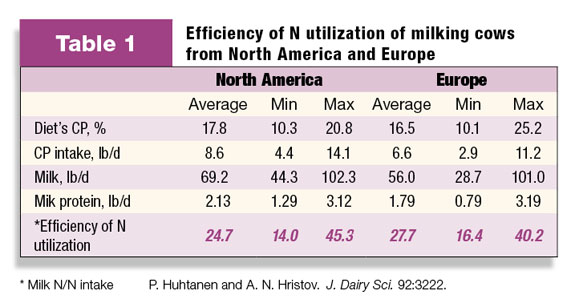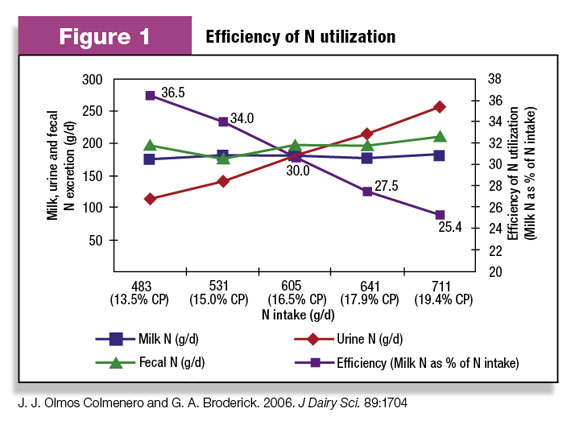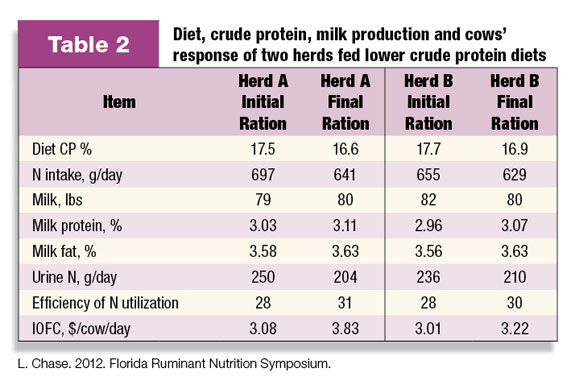Cows have a history of being easy targets for blame. Mrs. O’Leary’s cow was credited with starting the fire that burned down Chicago when she kicked an unfortunately placed lantern on Sunday, October 8, 1871. Now, some 140 years later, cows are being blamed for methane pollution and for the inefficient use of nitrogen in feedstuffs, an inefficiency tied to pollution from needlessly high levels of nitrogen in urine.

Let’s examine that last claim. We can calculate the efficiency of nitrogen use by dividing the amount of nitrogen secreted in milk by the amount of nitrogen consumed.On average, North American cows, then, are about 25 percent efficient (Table 1); European cows, 28 percent.
What’s striking in this report is the range of values for nitrogen utilization: 14 percent to 45 percent. Clearly a big range exists. The question is: Why such large differences?
The fact is, cows actually do efficiently use the nitrogen in feed rations. It’s humans who make them inefficient by overfeeding crude protein.
The good news is that lately crude protein in the diets fed to cows has been reduced from a somewhat “typical” 18 percent to a more “reasonable” 16 percent. This phenomenon is due to several factors: relative higher cost of protein concentrates, a better understanding and implementation of ration software formulations, a more intensive monitoring of feed quality, environmental concerns from the producer/nutritionists and a bulk of scientific information demonstrating that more crude protein in the diet is poorly correlated with more milk production.
How low can we go?
Although the scientific community has known for some time that more crude protein in the ration does not correlate with more milk production, under commercial situations cows have been routinely overfed protein for various reasons: poor feedbunk management, feed variability, lack of proper software for ration formulations, etc. However, none of these reasons relate to the cow’s ability to achieve an efficient use of the diet’s crude protein.

A trial that clearly shows what the cow does when fed excess protein was published in 2006. (See Figure 1). In that trial, researchers from the University of Wisconsin fed diets from 13.5 percent to 19.4 percent crude protein to lactating cows and reported the fate of the nitrogen consumed.
The higher the percentage of crude protein in the diet, the more nitrogen the cows consumed; however, the nitrogen secreted in the milk or in feces did not increase. The cows rid themselves of excess nitrogen by secreting it in their urine, the primary source of ammonia emissions into the atmosphere.
As expected, as the diet’s crude protein percentage increased, the efficiency of nitrogen utilization decreased, from 36 percent to 25 percent. Therefore, the cow’s efficiency in nitrogen utilization can be improved by feeding the right amount of crude protein. In today’s market environment, we must maximize the cow’s genetic potential to produce milk as efficiently as possible, and here lies an opportunity to make a difference.
It’s not that simple
I am not suggesting reducing the crude protein in the cow’s diets to 13.5 percent without any consideration – it is not that simple. Cows do not need crude protein per se. They need grams of essential amino acids to sustain a high level of milk production, maintain their metabolic needs and be healthy.
Reducing the crude protein of the diet without taking into consideration the amino acid levels and how they match the cow’s needs has a very negative impact on production, health and reproduction.
In order to reduce the daily nitrogen consumption of the cow successfully, the diet formulation has to be done properly. Today’s dairy consultants have the tools to estimate the nutritional quality of a diet. Specifically, these programs predict the amino acid levels available to the cow to meet her needs.
While today’s many commercially available software programs are far from being perfect, they do aid in the design of a better diet. The application of those programs allows the nutritionist to predict the nutrient output of a diet based on the feed’s individual ingredients. When the software is used wisely, the crude protein of the diet can be reduced and the amount of wasted nitrogen can be diminished for more efficient utilization of the diet’s nitrogen load without compromising the cow’s milk production or health.
The cow may surprise you

Lowering the nitrogen load has benefits beyond reducing nitrogen secretions in the urine and maximizing the efficiency of nitrogen utilization. Dr. Larry Chase, in the 2012 Florida Ruminant Nutrition Symposium (See Table 2), reported results from herds in which the crude protein of the diets was reduced by 1 percent.
The cows not only reduced the nitrogen secreted in the urine, they also responded with better milk protein and fat percentage. This, combined with a lower diet cost, resulted in a better income over feed cost from the cows fed lower crude protein diets.
As you may recall, the newspaper’s reporter took 22 years to admit to making up his story about Mrs. O’Leary’s cow, yet the cow continues to be blamed for the fire. Hopefully it won’t take the industry that long to begin feeding diets with lower crude protein and better amino acid balance. Given the opportunity, cows can and do efficiently use nitrogen. PD
References omitted due to space but are available upon request.( Click here
Luchini is the manager of ruminant product technical services for Adisseo, has a Ph.D. in Dairy Science from the University of Wisconsin and has received seven U.S. patents.






